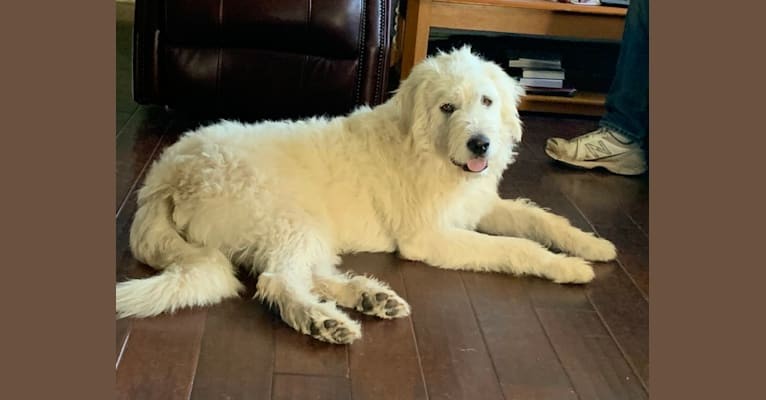
The Komondor Great Pyrenees mix represents a fascinating hybrid between two ancient European livestock guardian breeds - the Hungarian Komondor and the French Great Pyrenees. Standing 25.5-32 inches tall and weighing 70-110+ pounds, this large mixed breed inherits the protective instincts, loyalty, and independent nature of both parent breeds. While their appearance can vary significantly based on dominant genes, they consistently display an affectionate yet stubborn temperament that requires experienced handling. Their unique combination of traits makes them excellent family guardians, though proper training and socialization from puppyhood are essential for successfully integrating these powerful dogs into domestic settings.
Size and Physical Characteristics
Distinctive Appearance Features
The Komondor Great Pyrenees mix combines physical traits from both parent breeds, resulting in a large dog standing 25.5-32 inches tall and weighing between 70-110+ pounds. Their coat appearance can vary significantly depending on which parent breed they take after more - potentially inheriting either the Komondor's distinctive corded coat or the Great Pyrenees' fluffy double coat. Common coat colors include white, gray, tan, badger and reddish-brown.
Coat Care Requirements
The grooming needs vary based on which parent's coat type is dominant. If the dog inherits the Komondor's corded coat, regular cord separation and trimming is required to prevent matting, with baths needed frequently but drying time taking up to 2.5 days. For those with a Great Pyrenees-type coat, weekly brushing helps manage shedding and maintain coat condition. In either case, proper grooming is essential not just for appearance but also to prevent skin issues like hot spots that can develop in neglected coats.
Health and Genetic Considerations
This mix is generally healthy but may inherit certain conditions common to both parent breeds. Major health concerns include hip and elbow dysplasia, osteochondro dysplasia affecting bone/cartilage growth, and gastric dilatation volvulus (GDV/bloat). Eye conditions like entropion, cataracts and canine multifocal retinopathy can also occur. Regular veterinary checkups are important for early detection of any issues. Their lifespan typically ranges from 10-12 years with proper care.
Physical Characteristics and Appearance of the Komondor Great Pyrenees Mix
Sexual Dimorphism
While both genders exhibit impressive size, there are notable differences between males and females of this mix. Males typically reach heights up to 32 inches and weights of 115+ pounds, while females stand around 27 inches and weigh up to 100 pounds. These size differences help distinguish gender but don't significantly impact their overall appearance or capabilities.
Temperament and Personality Traits of the Komondor Great Pyrenees Mix
Guardian Instincts and Family Dynamics
This mix exhibits strong protective instincts inherited from both parent breeds' livestock guardian backgrounds. They are naturally wary of strangers but show deep affection and loyalty toward family members. While excellent with children, supervision is recommended due to their size and potential misinterpretation of rough play. Their protective nature manifests through powerful barking when perceiving threats, though they prefer vocal intimidation over physical confrontation.
Independence and Training Considerations
These dogs demonstrate remarkable intelligence but can be challenging to train due to their independent and strong-willed nature. Unlike more obedient breeds, they were bred to think independently rather than constantly look to humans for guidance. They require an experienced owner who can establish clear leadership while respecting their natural instincts to guard and protect.
Exercise and Activity Requirements
Daily Physical Activity Needs
The Komondor Great Pyrenees mix requires approximately 60 minutes of daily exercise, typically split between multiple walks. While they are athletic and agile, they don't need intense exercise. Free-running time in a securely fenced area is beneficial, but dog parks are not recommended due to their guardian instincts. Unlike high-energy breeds, they prefer moderate activity levels that align with their working dog heritage.
Mental Stimulation Requirements
These dogs benefit from varied training sessions that keep them mentally engaged. Puzzle toys and problem-solving exercises help channel their intelligence constructively. However, their independent nature means they may not always eagerly participate in training activities. Exercise should be carefully timed around meals to prevent bloat, a serious health concern for this breed. Their exercise needs should be balanced with adequate rest periods, as they also value quiet time to monitor their surroundings, reflecting their guardian breed instincts.
Note: While previous sections covered general temperament and physical characteristics, this section specifically focuses on exercise requirements and mental stimulation needs unique to this mix breed.
Conclusion
The Komondor Great Pyrenees mix represents a unique combination of two guardian breeds, resulting in a large, protective dog weighing 70-110+ pounds with distinctive physical characteristics. Their coat type can vary significantly between the Komondor's corded coat or the Great Pyrenees' double coat, requiring dedicated grooming attention either way. While generally healthy, they may face some inherited health concerns including hip dysplasia and bloat, with a typical lifespan of 10-12 years.
These dogs exhibit strong protective instincts and independence, making them excellent guardians but potentially challenging to train. They require around 60 minutes of daily moderate exercise and mental stimulation, though their independent nature means they may not always eagerly participate in training activities. For potential owners, the key considerations are providing adequate space, committing to regular grooming, and having experience with independent breeds. Their combination of protective instincts, size, and grooming needs makes them best suited for experienced dog owners who can provide consistent training and proper care.